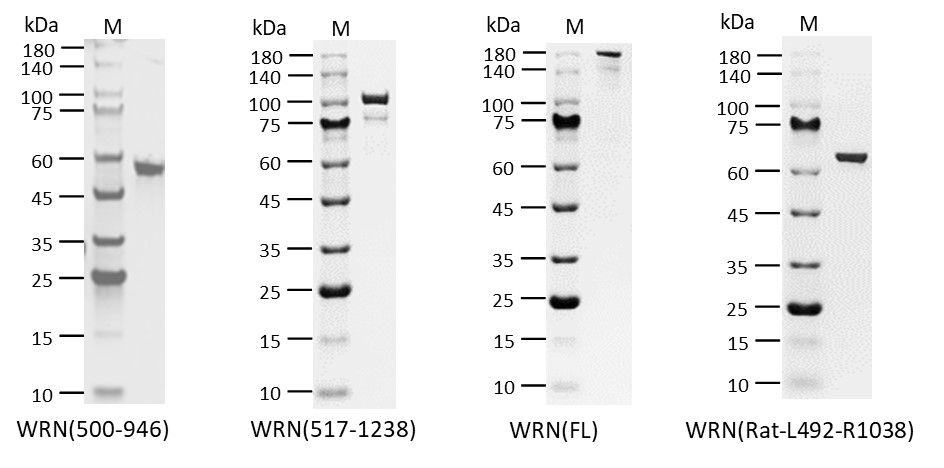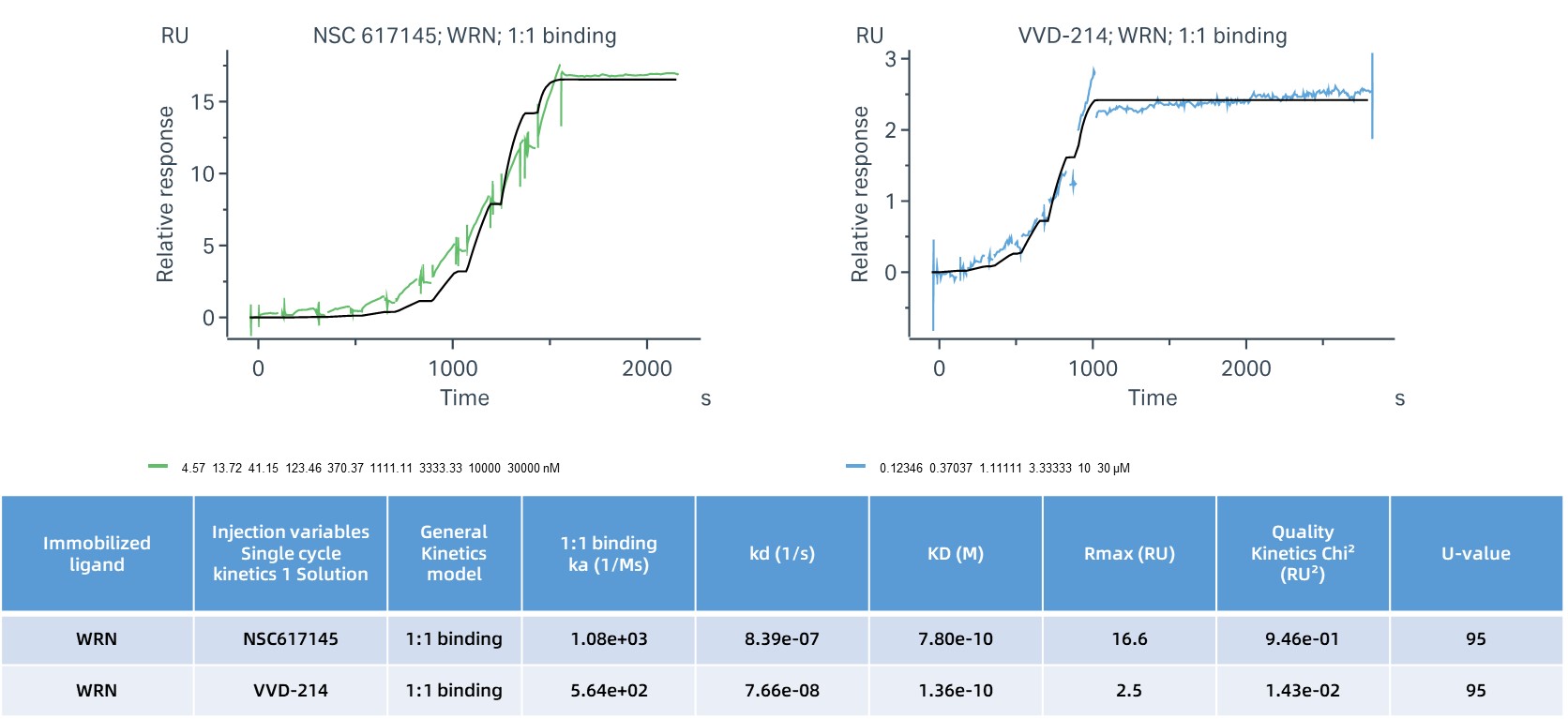Werner Syndrome RecQ Helicase (WRN) is a member of the RecQ helicase family, enzymes that play a crucial role in maintaining genomic stability. WRN is involved in DNA repair, replication, recombination, and telomere maintenance. Mutations in the WRN gene lead to Werner syndrome, a disorder characterized by premature aging and increased cancer susceptibility. Recent studies have highlighted WRN as a promising therapeutic target, especially in cancer treatment. The loss of WRN function has been shown to selectively kill cancer cells with microsatellite instability-high (MSI-H), a condition prevalent in various cancers such as colorectal, endometrial, and gastric cancers. This selective lethality positions WRN as a potential target for developing targeted cancer therapies. ICE Bioscience is at the forefront of this innovative research, offering a comprehensive suite of services to support WRN drug discovery efforts.
At ICE Bioscience, we offer a diverse range of WRN proteins, available both as part of our service offerings and as standalone products for purchase. Our WRN protein products cater to various research needs, ensuring high quality and activity for reliable experimental results.

Available WRN Proteins:
WRN(500-946), WRN(517-1238), WRN(FL) (Full-Length), WRN(Rat-L492-R1038)
These WRN proteins, expressed using the insect cell expression system, demonstrate high purity and exhibit excellent activity in ADP-Glo and fluorescence intensity (FI) assays, making them ideal for biochemical and biophysical studies.
Comprehensive RecQ Family Protein Offering
In addition to WRN proteins, ICE Bioscience also provides a range of RecQ family proteins, which are crucial for conducting selectivity assays. These proteins allow researchers to compare the inhibition effects on different RecQ family members, ensuring the specificity of potential WRN inhibitors.
Available RecQ Proteins:
RecQ1, RecQ4, RecQ5, BLM
The RecQ family proteins were expressed using the E. coli expression system. Similar to our WRN proteins, the RecQ proteins also exhibited high purity and demonstrated good activity in ADP-Glo assays.
ADP-Glo Assay

The ADP-Glo assay is a robust method to measure the helicase activity of WRN by detecting the ADP generated during ATP hydrolysis. WRN helicase uses the energy from ATP hydrolysis to unwind nucleic acid structures, and the level of activity is indicated by the amount of ADP produced in the reaction.

Unwinding Assay

The unwinding assay detects WRN helicase activity by monitoring the separation of double-stranded DNA, leading to increased fluorescence. The DNA probe is labeled with a fluorophore and a quencher. When WRN unwinds the DNA, the strands separate, and fluorescence is released, indicating helicase activity.

▶ Multiple Protein Lengths and Species-Specific Assays: ICE Bioscience offers WRN biochemical assays using various lengths of WRN proteins (WRN(500-946), WRN(517-1238), and WRN(FL)), and species-specific assays using WRN(492-1038) from rats. This versatility ensures that the assays meet diverse research needs and provide reliable data.
▶ High Purity and Activity Validation: Both assays utilize WRN proteins expressed in insect cells, ensuring high purity and proper folding. The proteins exhibit robust activity in ADP-Glo and unwinding assays, validated through luminescence and fluorescence measurements.
▶ Selectivity Screening with RecQ Family Proteins: To ensure the specificity of potential WRN inhibitors, we also offer ADP-Glo assays for other RecQ family proteins (RecQ1, RecQ4, RecQ5, and BLM). This allows for comprehensive selectivity screening, ensuring that compounds specifically target WRN without off-target effects on other RecQ proteins.
ICE Bioscience offers state-of-the-art Surface Plasmon Resonance (SPR) assays for studying the binding kinetics and affinity of potential inhibitors to the WRN helicase. Our SPR services provide detailed kinetic data essential for drug discovery and development, ensuring a comprehensive understanding of the interactions between WRN and various compounds.
SPR Assay Overview
Surface Plasmon Resonance (SPR) is a powerful technique used to measure the interaction between biomolecules in real time without labeling. This method provides key insights into the binding kinetics, including association (ka) and dissociation (kd) rates, as well as the equilibrium dissociation constant (KD), and maximum binding response (Rmax).

ICE Bioscience’s SPR assays provide critical insights into the binding interactions between WRN and potential inhibitors. Our high-quality, detailed kinetic data help in understanding the mechanisms of action of these compounds, supporting the development of targeted therapies for conditions associated with WRN dysfunction.
Accurate detection and quantification of WRN protein levels are essential for understanding the mechanisms of WRN-targeted therapies and assessing their effectiveness. ICE Bioscience offers a comprehensive suite of assays for detecting and monitoring WRN protein expression and degradation, utilizing advanced technologies to ensure precise and reliable results.
WRN HiBiT Cell Line: Constructed for sensitive and accurate detection of WRN protein levels, utilizing the luminescent HiBiT tag for quantitative measurement in living cells.
Western Blot (WB) Assay: Detects and quantifies WRN protein levels through electrophoresis and immunoblotting, providing detailed information on protein size and expression.
JESS (Simple Western) Assay: An automated capillary-based electrophoresis platform for high-throughput and reproducible protein analysis, simplifying the traditional Western blot process.

In-Cell Western (ICW) Assay: High-throughput method for quantifying WRN protein levels directly in fixed cells, using specific antibodies and infrared dye-labeled secondary antibodies.
Understanding the effects of WRN-targeted therapies on cell viability is crucial for developing effective cancer treatments. ICE Bioscience offers comprehensive cell viability assays and cancer cell panel screening services tailored for WRN drug discovery. Our services include both fixed and customized cell panels, providing flexibility and precision in evaluating potential WRN inhibitors.
Cell Viability Assay: The cell viability assay measures the ability of WRN-targeted compounds to inhibit the proliferation of cancer cells using the CellTiter-Glo® (CTG) method. The CTG assay determines cell viability based on quantifying ATP, which indicates metabolically active cells. The luminescent signal produced is proportional to the number of viable cells, allowing for accurate measurement of cell viability.
Clonogenic Assay: The clonogenic (or colony formation) assay evaluates the ability of a single cell to grow into a colony. This assay is used to assess the long-term effects of WRN-targeted therapies on cell survival and proliferation.
Cancer Cell Panel Screening: This screening involves testing compounds across a panel of cancer cell lines with varying genetic backgrounds. It helps in identifying the efficacy and selectivity of compounds against specific cancer types.

Our WRN cell viability and cancer cell panel screening services support various stages of drug development, including:
▶ Lead or Hit Compound Identification: Assessing cell line or cancer type sensitivity to potential lead compounds.
▶ Repurposing of Clinical Drugs or FDA-Approved Drugs: Evaluating new therapeutic indications for existing drugs by screening them against a comprehensive panel of cancer cell lines.
▶ Development of Novel Molecular Entities: Facilitating the development of new molecular entities, such as PROTACs, molecular glues, antibody-drug conjugates (ADCs), and peptide-drug conjugates (PDCs).
▶ IND Application Support: Generating essential data for Investigational New Drug (IND) submissions, ensuring robust and reliable preclinical evidence.
▶ Biomarker Discovery: Uncovering novel biomarkers through integrative bioinformatics analysis, enhancing the development of precision therapies.
▶ Innovative Therapeutic Strategies: Investigating combination therapy approaches by systematically evaluating the efficacy of various drug combinations.
ICE Bioscience offers comprehensive cell-derived xenograft (CDX) models for evaluating WRN-targeted therapies. Our CDX models, including both human and mouse-derived cell lines, provide robust platforms for in vivo drug efficacy studies, biomarker discovery, and resistance mechanism exploration.
Example:
The SW48 cell line is known for its high microsatellite instability (MSI), which makes it a relevant model for studying the effects of WRN inhibitors (WRNi). Treatment with WRNi led to an increase in nuclei with chromosomal breaks, highlighting the potential efficacy of WRNi in targeting MSI-high cancers.

Resistance Study: WRN Inhibitor Resistance in HCT116 CDX Model
In our HCT116 CDX model, we identified the development of resistance to the WRN inhibitor HRO761. After administering the drug, we observed the emergence of resistant cells within 40+ days. These cells were isolated from the treated animals and expanded in vitro. The isolated resistant cells underwent further induction and culture. When retested with HRO761 in cell viability assays, these cells consistently displayed stable resistance, confirming the robustness of the resistance phenotype.


2025-10-30
2025-10-23
2025-09-28
2025-08-19
We value your inquiries and are here to provide you with tailored solutions for your drug discovery and development needs. Whether you have questions, require more information, or are interested in discussing potential collaborations, our team of experts is just a message away.
Feel free to reach out to us.